Original URL: https://www.theregister.com/2012/12/24/hyperx_3k_240g_review/
Review: Kingston Hyper-X 3K 240GB SSD
Kingston targets fans... and mostly doesn't disappoint
Posted in Storage, 24th December 2012 12:26 GMT
Feeding the 10Gbit monster To build storage capable of running tests that can challenge 10Gbit network cards and switches, a flash array is required. I chose eight Kingston Hyper X 3K 240 SSDs to provide this high-speed storage layer. Before I built my VMware cluster of ultimate doom, however, the SSDs needed some torture testing.
The drives advertise themselves as running somewhere north of 500MB/sec for reading and writing data. If you venture over to Tom's Hardware and take a look at the performance charts for 64-bit queue depth, you'll find the measured performance is significantly slower: 217.81MB/sec write and 187.61MB/sec read for random accesses. Let's see if they stack up.
Unboxing
I didn't pay a great deal of attention when actually ordering the drives and ended up getting Kingston upgrade kits along with the drives. Each came with 2.5" to 3.5" mounting rail as well as a 2.5" USB chassis. They also came with a small magnetic screwdriver that became high demand items around the lab and instantly disappeared. The kit also comes with the software required to do migrations; in short, everything you need to migrate from your existing hard drive to the new Kingston SSD.
The SSD itself feels well-built. It sits in the hand like a solid hunk of metal and doesn't have the cheap plastic feel I've come to expect with so many other consumer drives. The screwdriver that ships in the upgrade kit is similarly impressive: it feels like it should be some form of ammunition instead of merely a screwdriver.

I have less nice things to say about the 2.5" USB chassis. In theory, laptop users can use the USB chassis to turn their old drive into an external drive and continue using it. In reality it is a cheap piece of plastic and the first one lasted exactly 6 hours before it disintegrated. It is enough to get your data migrated, or serve very light duty as an on-desk external drive. It is not well built enough to handle prolonged testlab use, let alone serve road warriors.
Benchmarks
The Hyper-X SSDs perform as expected. After having fully preconditioned the drive, AS-SSD rates the sequential read speed on these drives as a hair over 500MB/sec; within a hair's breadth of the marketing on the box. The write speed in AS-SSD is a little over 300MB/sec.
An HDTune write run returns an average of 250MB/sec when connected to a 6Gbit SATA port and 160MB/sec when connected to a 3Gbit SATA port. If I run both read and write tests against the drives simultaneously, I obtain an average of 147.1MB/sec in each direction simultaneously.
Fully random testing with HDTune returned 7231 IOPS at 512bytes transfer size, 5157 at 4K and 786 IOPS - and an impressive 399MB/sec - with fully random transfer sizes. Impressive.
I compared this to a Sandisk Extreme 240GB SSD. The Sandisk returned a higher average write speed – almost 300MB/sec – but the performance was not nearly as stable as the Kingston. The write speed jumped all over the place and no matter how hard I preconditioned the drive – or which applications I used to test – the beginning of the write tests were always reported a significantly lower write speed than the average over long transfers.
The Sandisk returned a eye-watering 18008 IOPS with a 512 bytes transfer size and an incomprehensible 21260 IOPS at 4K transfer size. At small transfer sizes, the Hyper-X does not stack up well at all. With completely random transfer sizes, the Sandisk returns a more realistic 722 IOPS and a reasonable 366MB/sec.
I also benched several spinning rust disks to offer a comparison.
A Western Digital Raptor 150GB returns an average 70.8MB/sec write, 117 IOPS at 512 bytes, 114 IOPS at 4K, 48 IOPS Random (24.7 MB/sec).
A Western Digital Velociraptor 300GB returns an average 161.8MB/sec write, 300 IOPS at 512 bytes, 270 IOPS at 4K, 112 IOPS Random (56.9 MB/sec).
A Western Digital Caviar Black 500GB returns an average 142.0 MB/sec, 165 IOPS at 512 bytes, 139 IOPS at 4K, 65 IOPS Random (33.5 MB/sec).
A Seagate 7200.14 3TB returns an average of 158.6 MB/sec, 1821 IOPS at 512 bytes, 46 IOPS at 4K, 45 IOPS Random (23.2MB/sec).
The Hyper-X clearly slaughters my random sampling of spinning rust. The Sandisk has the benchmark-friendly IOPS at the small transfer sizes, but an unstable response that makes me very nervous. I didn't see any real-world advantages to the Sandisk in any of my real world tests, and the nice flat response line in my tests makes it far easier for me to trust the Hyper-X.
Real world use cases
I set the Hyper-X SDDs in various different real-world use cases; they have proven to be impressive devices for nearly all workloads. When compared to other SSDs (or spinning rust + controller card storage arrays) the Hyper-X are only middling at sequential access, but they truly shine at high-queue depth random access.
If I'm laying down large sequential files I would honestly much rather have Seagate 7200.14s; they are nearly as fast as the Hyper-X for this use case but you get 3TB instead of 240GB. This makes the Hyper-X of questionable value in a Video Gaming rig, for example. Most of my video games read texture files in a very sequential way during game initialisation and then run entirely out of RAM. Similarly, the Hyper-X is absolutely pointless for storing bulk media - there is no noticeable difference between 7200.14 and the Hyper X when playing video.
Outside of these sequential use cases, however, the Hyper-X is not only a step up from any of the spinning rust disks I have to play with, but wipes the floor with my Intel 510 SSDs and any of the OCZ stuff I still have lying around. Without question, Windows loads faster. Most applications see a significant improvement and finally I'm able to do video editing in real time. Web browser launch times are completely unaffected by use of the Hyper-X, but loading and navigating rich websites and HTML5 applications sees a marked improvement.
The most noticeable improvement was as a datastore for virtual machines. VMware Workstation 9 is something I use heavily. Running 8 VMs at a time could get pretty laggy on the Intel 510, but the Hyper-X soaked up the I/O like a champ.
Conclusion

The final destination for my Hyper-X SSDs is not a notebook or a desktop, but a server. These are consumer devices and not designed for enterprise use, but for a test lab environment they've been brilliant. For years Kingston has been a brand I have trusted without reservation for my server RAM. It was based on the strength of that reputation that I chose them for my test lab SSDs.
I managed to score eight of these drives on sale from Newegg for $159. They are regularly $199. A quick calculation shows that to read the theoretical limit of 10Gbit ethernet – 1280MB/sec – I would need at least 7 drives. Controller cards come in 8 ports, so 8 drives it is. I picked up a Supermicro AOC-SAS2LP-MV8. With the SSDs, the test lab's high-speed array comes to a little over $1,400.
That's a lot of cash out of pocket - it will take months to pay this array off. Having run the tests and given enough time for buyer's remorse to take hold, I still think I bought the right disks. $1,400 gives me an array that can reach over 1000MB/sec sustained throughput reading and writing simultaneously. Even using Windows RAID, I can hammer the array with random I/O from a 3-node VMware cluster and maintain those numbers. ®

